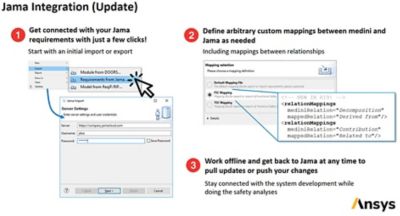-
United States -
United Kingdom -
India -
France -
Deutschland -
Italia -
日本 -
대한민국 -
中国 -
台灣
-
Ansys는 학생들에게 시뮬레이션 엔지니어링 소프트웨어를 무료로 제공함으로써 오늘날의 학생들의 성장을 지속적으로 지원하고 있습니다.
-
Ansys는 학생들에게 시뮬레이션 엔지니어링 소프트웨어를 무료로 제공함으로써 오늘날의 학생들의 성장을 지속적으로 지원하고 있습니다.
-
Ansys는 학생들에게 시뮬레이션 엔지니어링 소프트웨어를 무료로 제공함으로써 오늘날의 학생들의 성장을 지속적으로 지원하고 있습니다.
Ansys Blog
September 6, 2018
Linking Safety Management Software Simplifies ADAS and Autonomous Car Design
Market demands are directing the automotive industry toward advanced driver-assistance systems (ADAS) and autonomous cars. Naturally, ADAS and autonomous systems add complexity to automotive products. This complexity breeds vulnerabilities that could plague safety management engineers.
These engineers must ensure the functional safety of their products to reduce liability and the risk to customers. Let’s face it, one class-action lawsuit could lead to bankruptcy.
Engineers designing ADAS and
autonomous cars can consolidate
functional and safety management
software by interfacing medini
analyze to Jama
Industry standards state that in order to ensure functional safety you must trace safety requirements to specific product properties. Unfortunately, tracing these links can be complex when your safety requirement software doesn’t talk to your requirements management software.
Ansys addresses this issue with its bidirectional interface between medini analyze and Jama. medini analyze is a model-based safety methods and analysis software; Jama is a requirements definition, management, verification and validation software.
“Industry standards mandate that appropriate processes and tools are needed to manage safety requirements,” says Jan Mauersberger, lead software architect at Ansys. “Using this interface, engineers will manage all safety requirements consistently. They are available for both safety analysis in medini and actual development via Jama.”
How to Link medini’s Safety Architecture to Jama’s Requirements Management
“medini analyze supports the systematic identification of safety requirements based on various properties,” says Mauersberger. “The tool allocates these requirements to elements of the safety architecture. By linking with Jama software, we align the management of safety requirements with all other requirements.”
To link these two software packages together, follow these steps:
Engineers can quickly link medini and Jama by defining
custom mappings and using push/pull updates
Once the bidirectional interface is set up, it can pull functional requirements from Jama that are related to safety systems. This information is then transferred to medini. Once the safety engineer has finished the work in medini, safety requirement data can then be exported back into Jama’s requirement management software.
The result of the link is that both the functional requirements and safety requirements can be managed within one workflow.
Learn More
To learn more about this and other applications where the interchange of safety requirements from medini into Jama might be required, watch this webinar.












